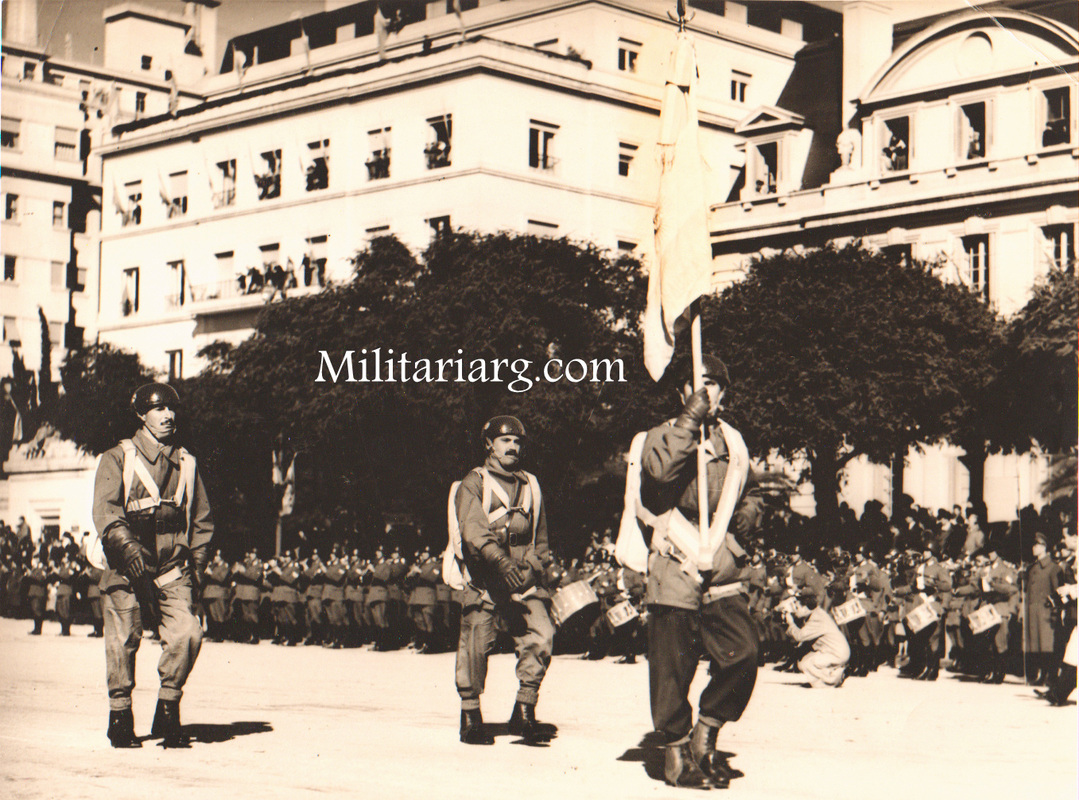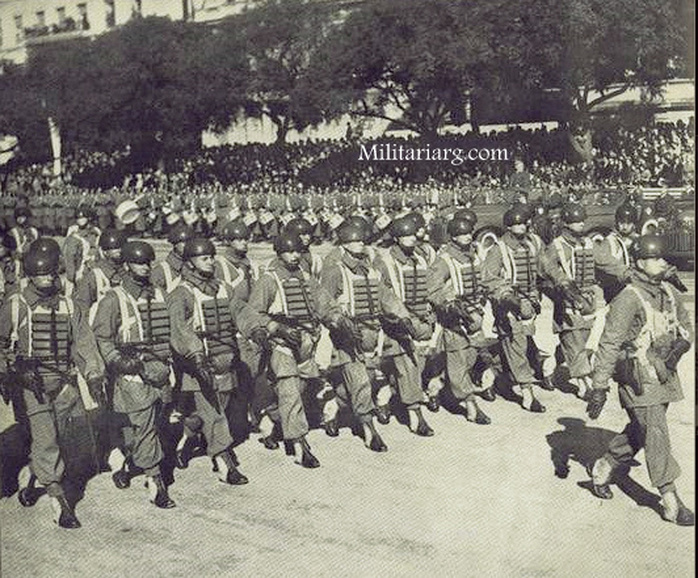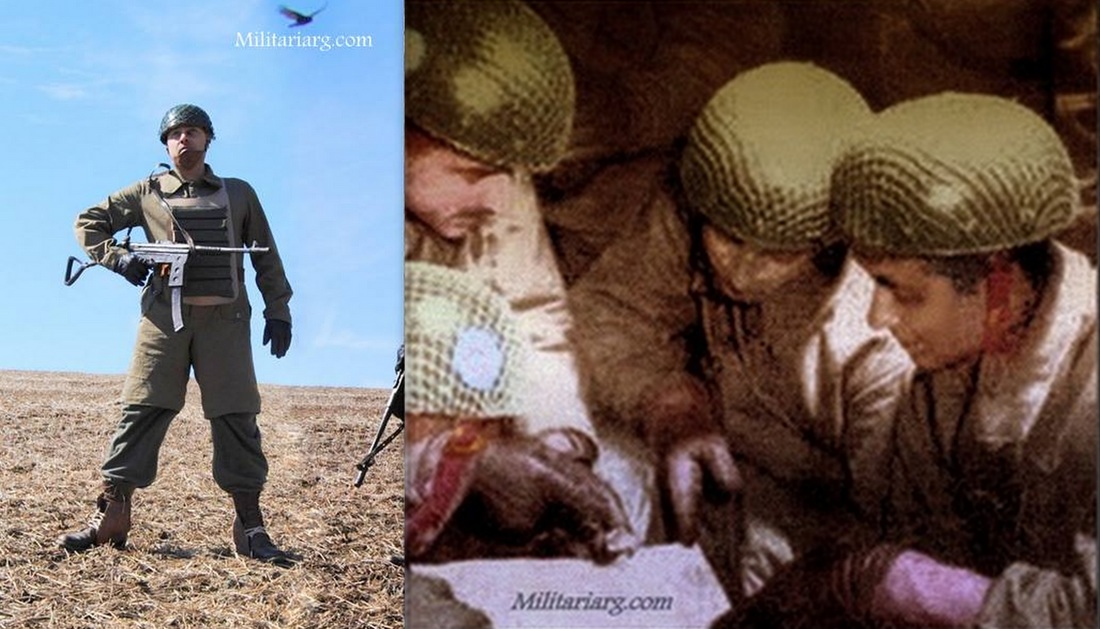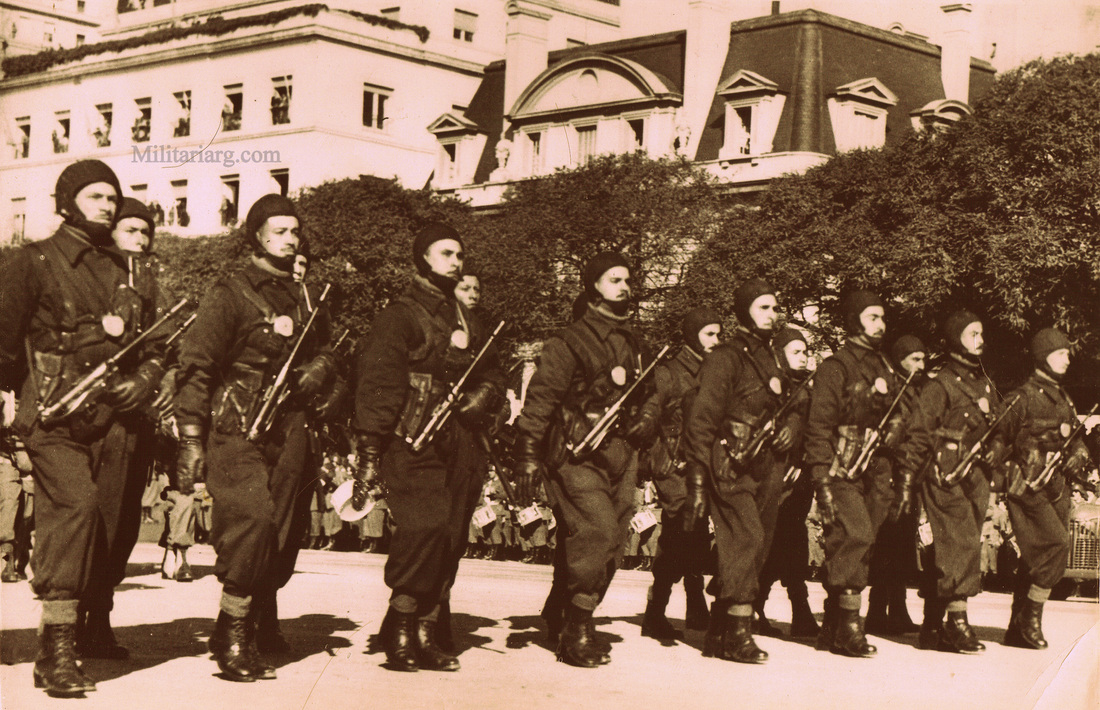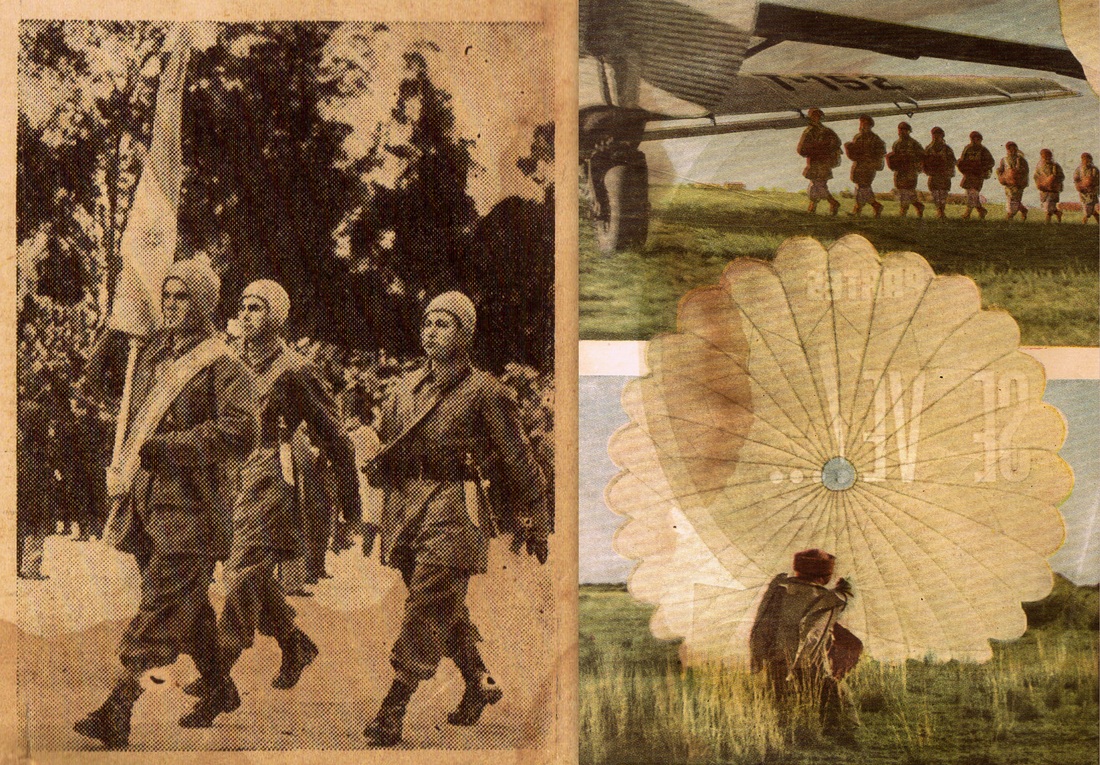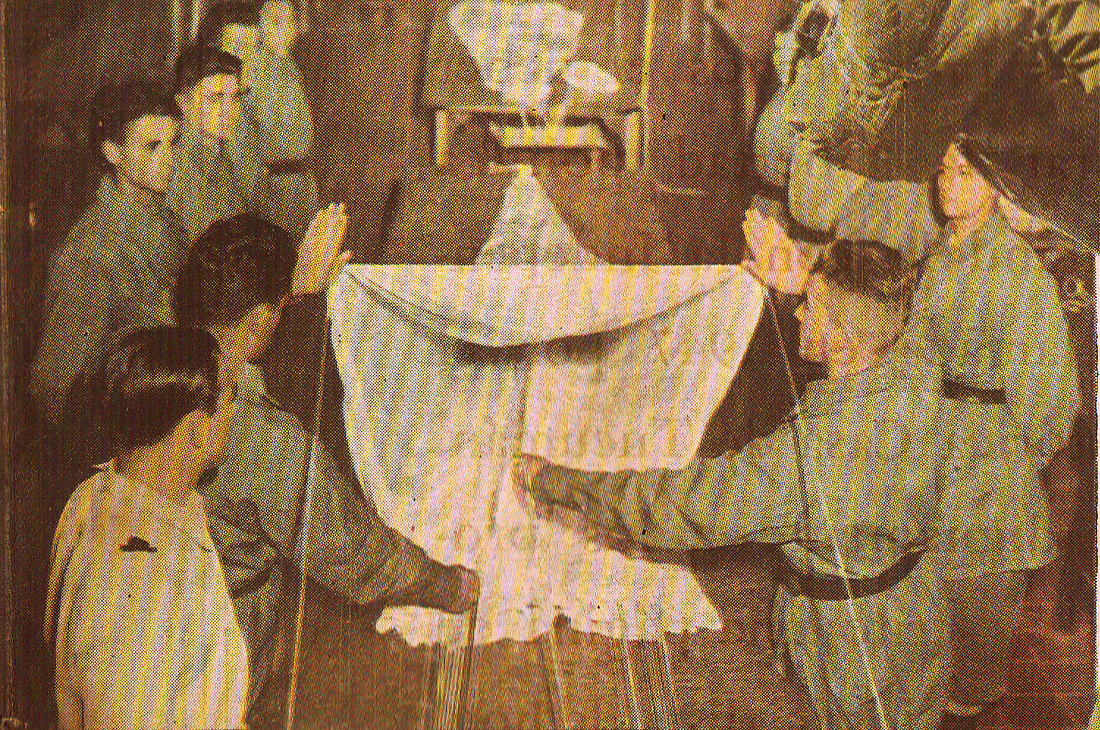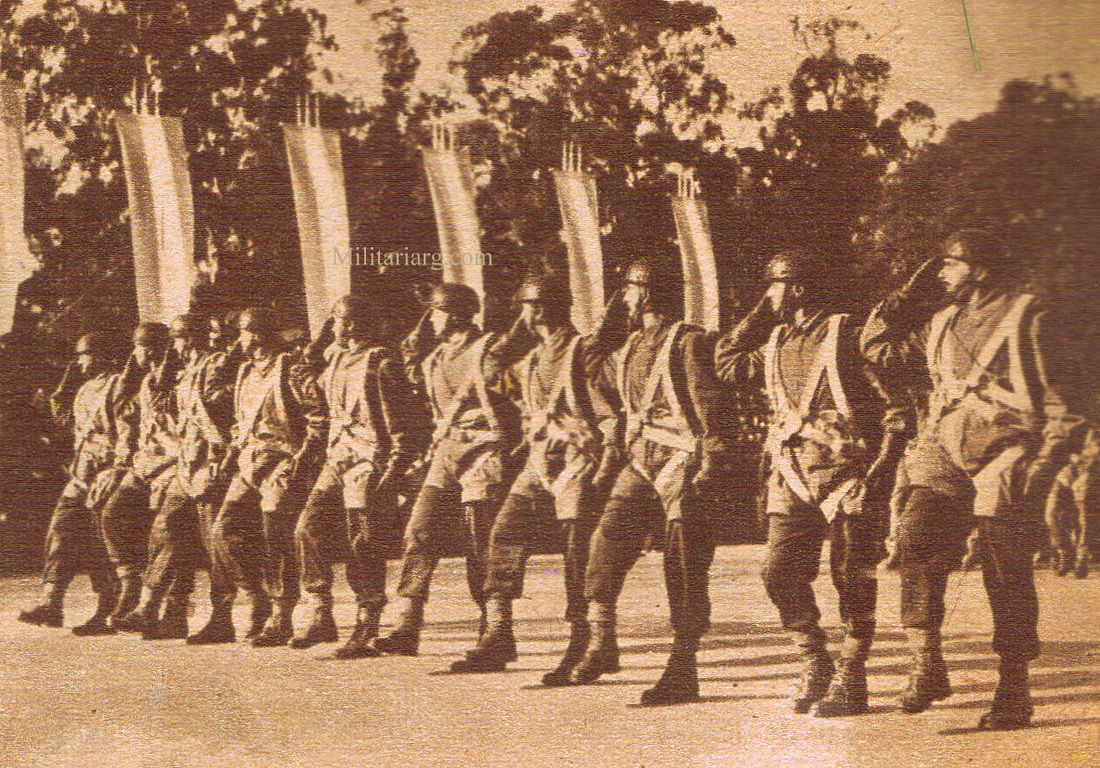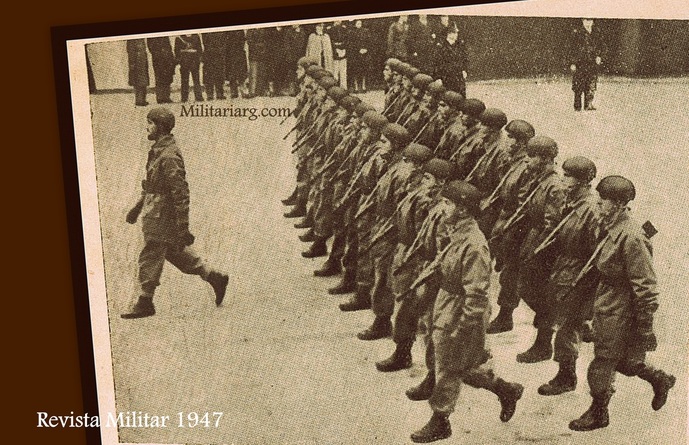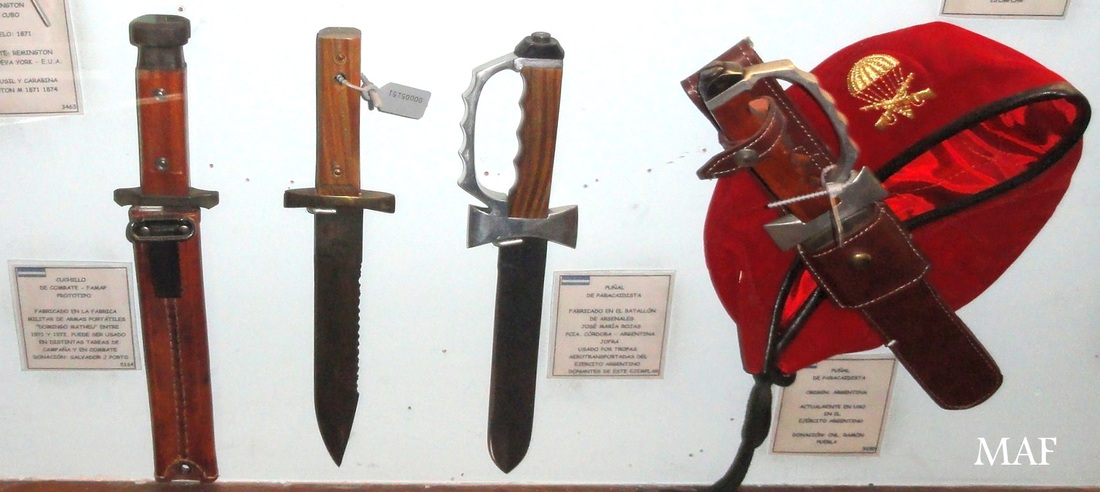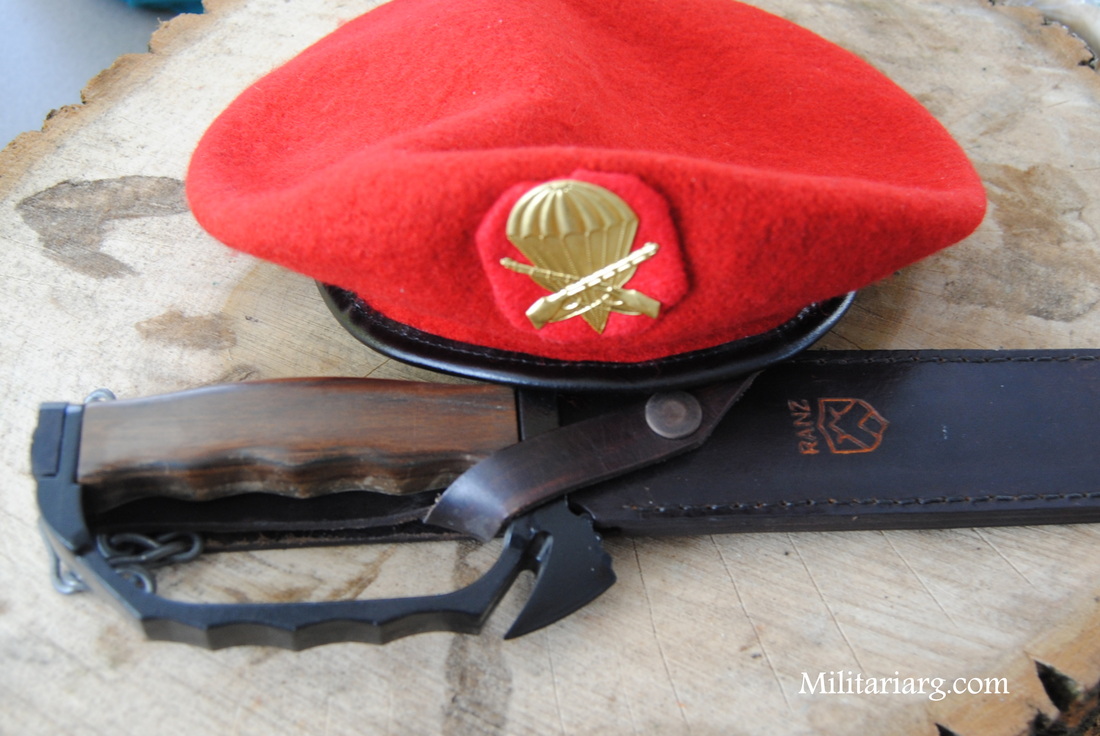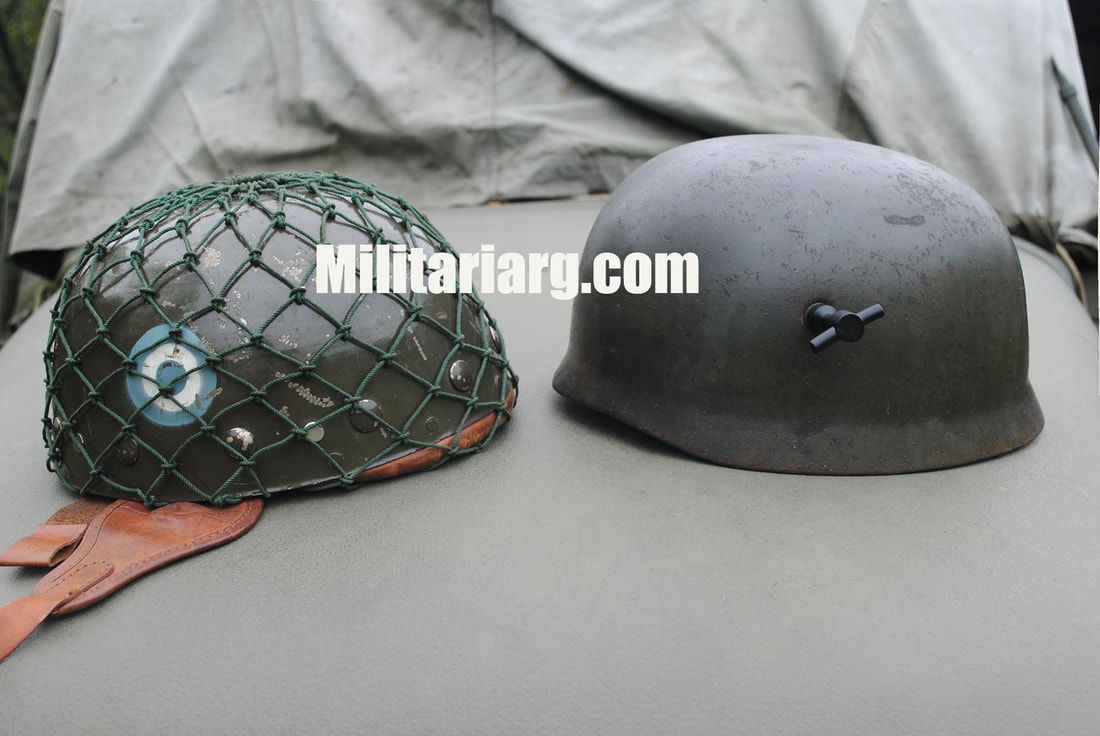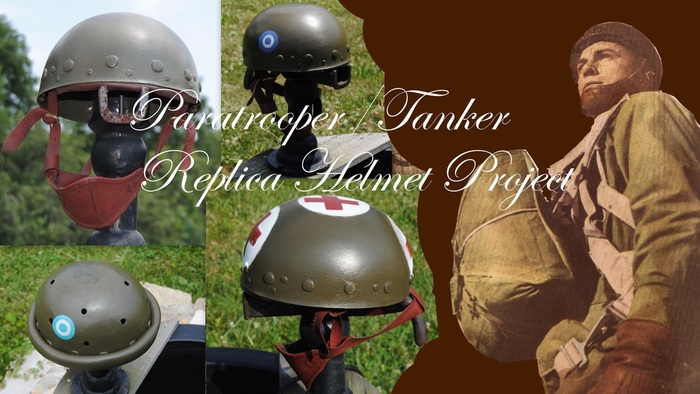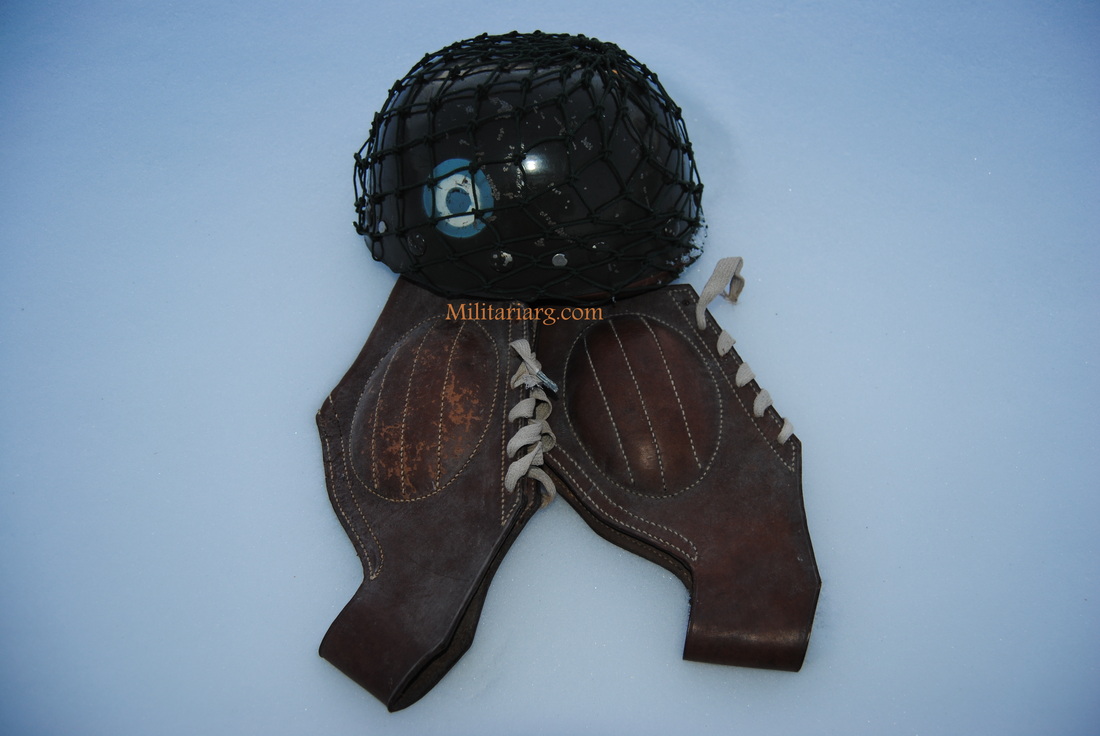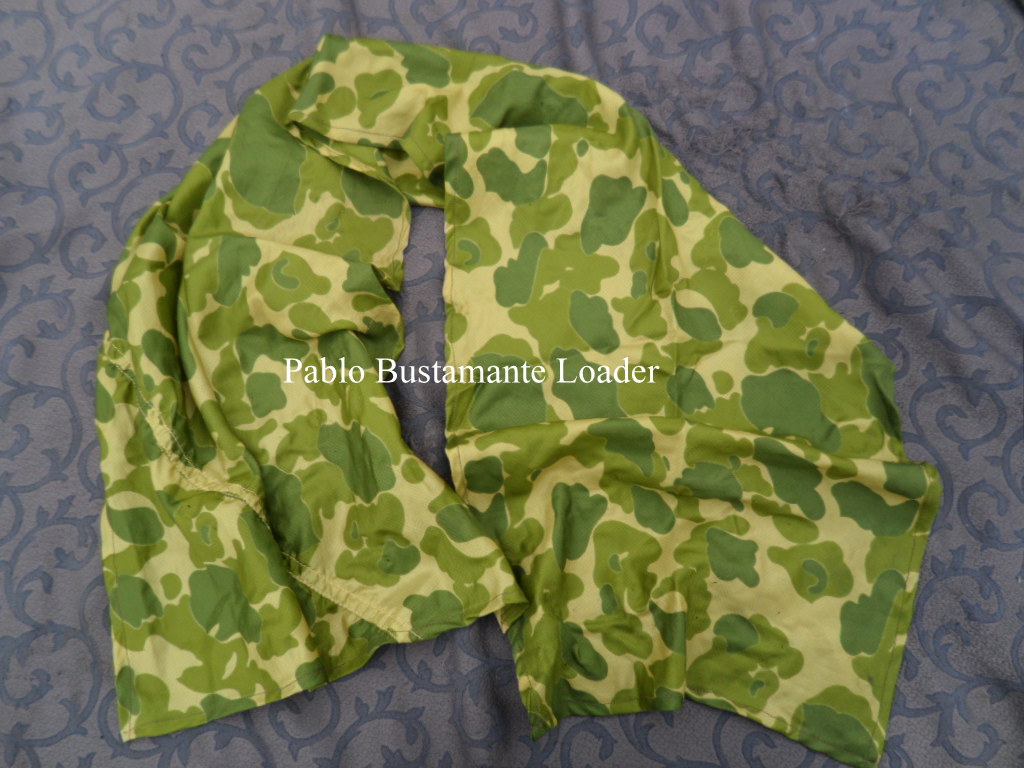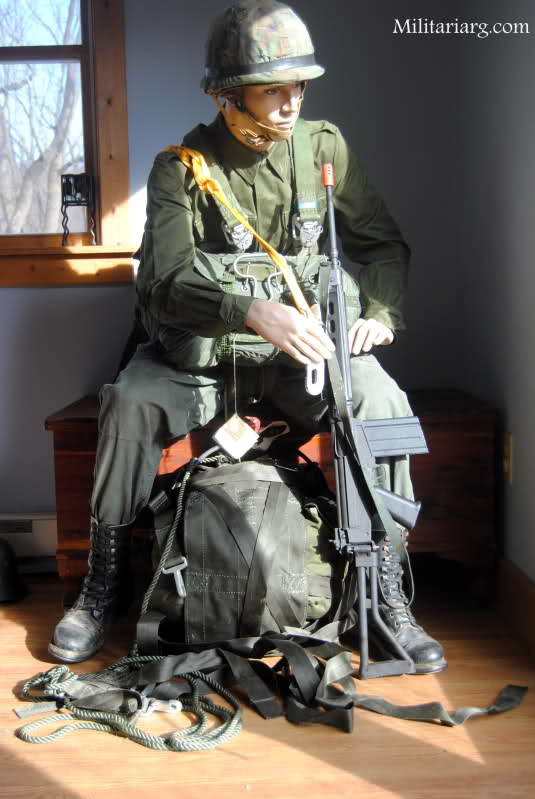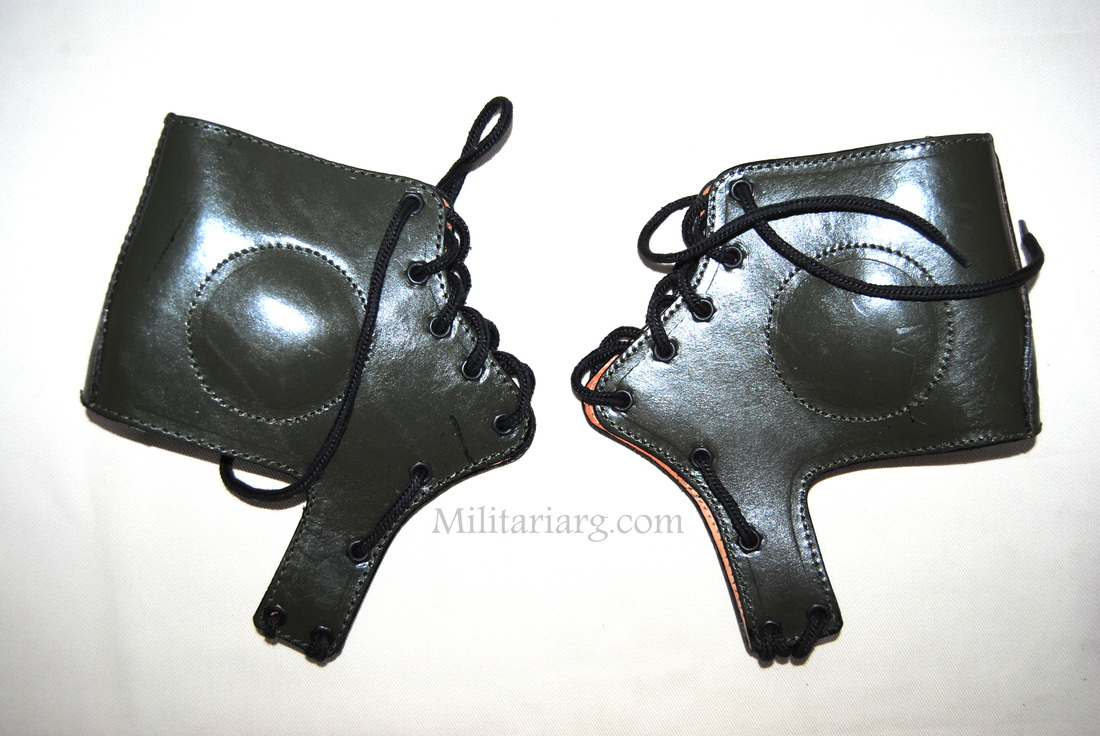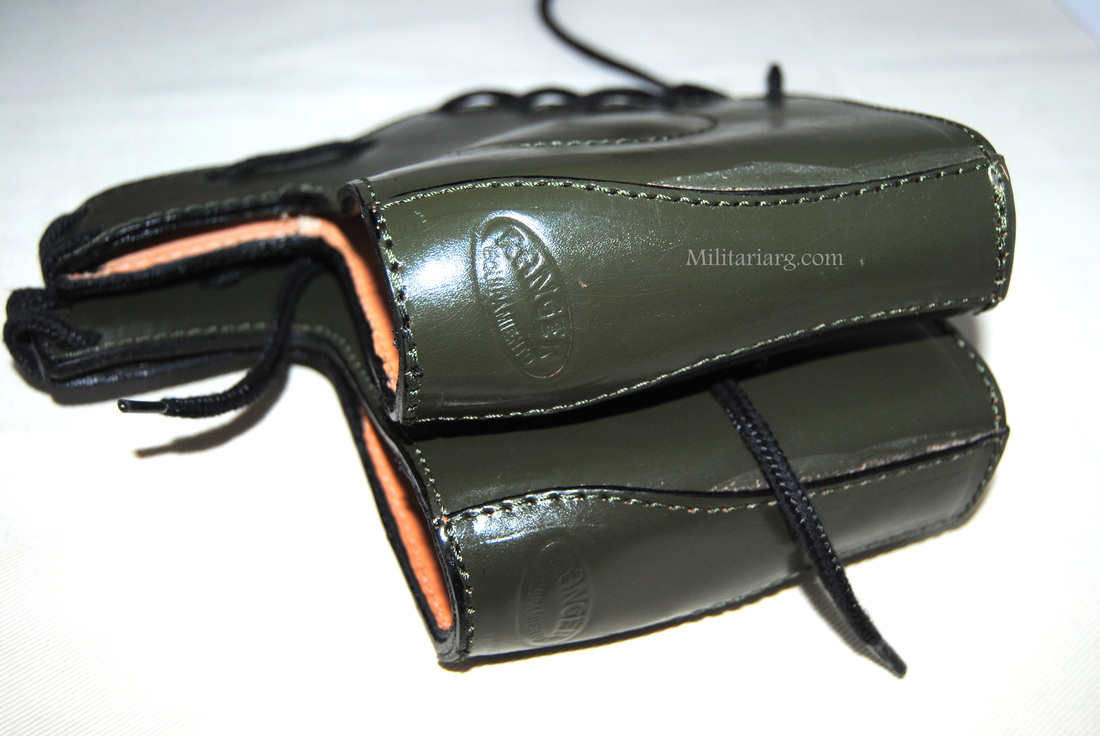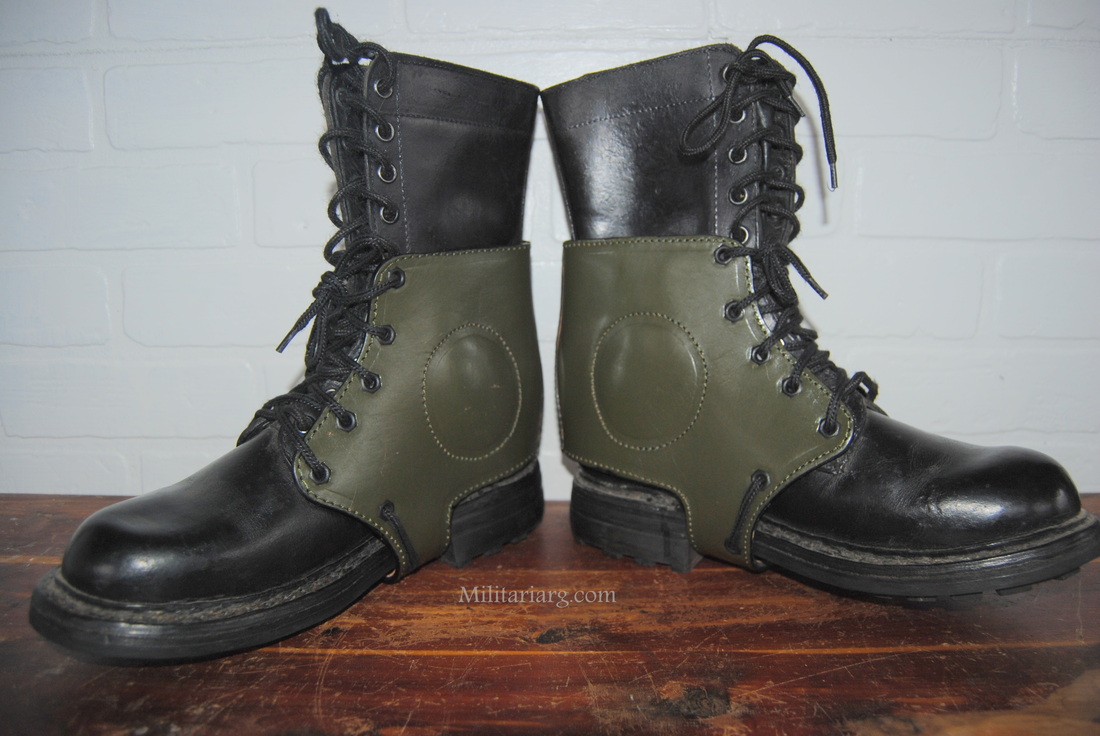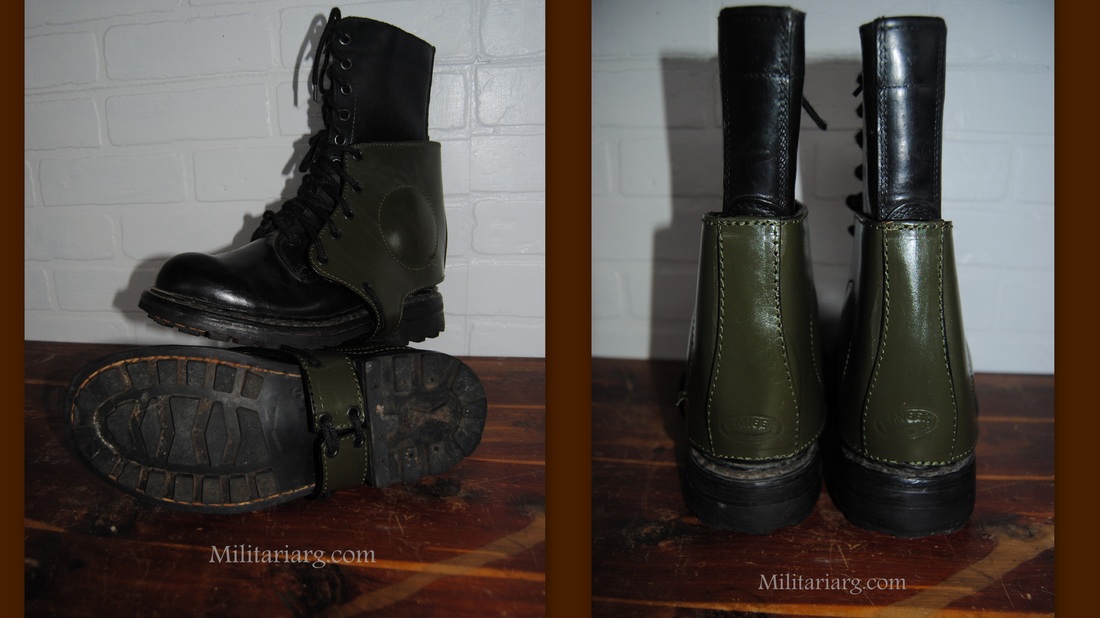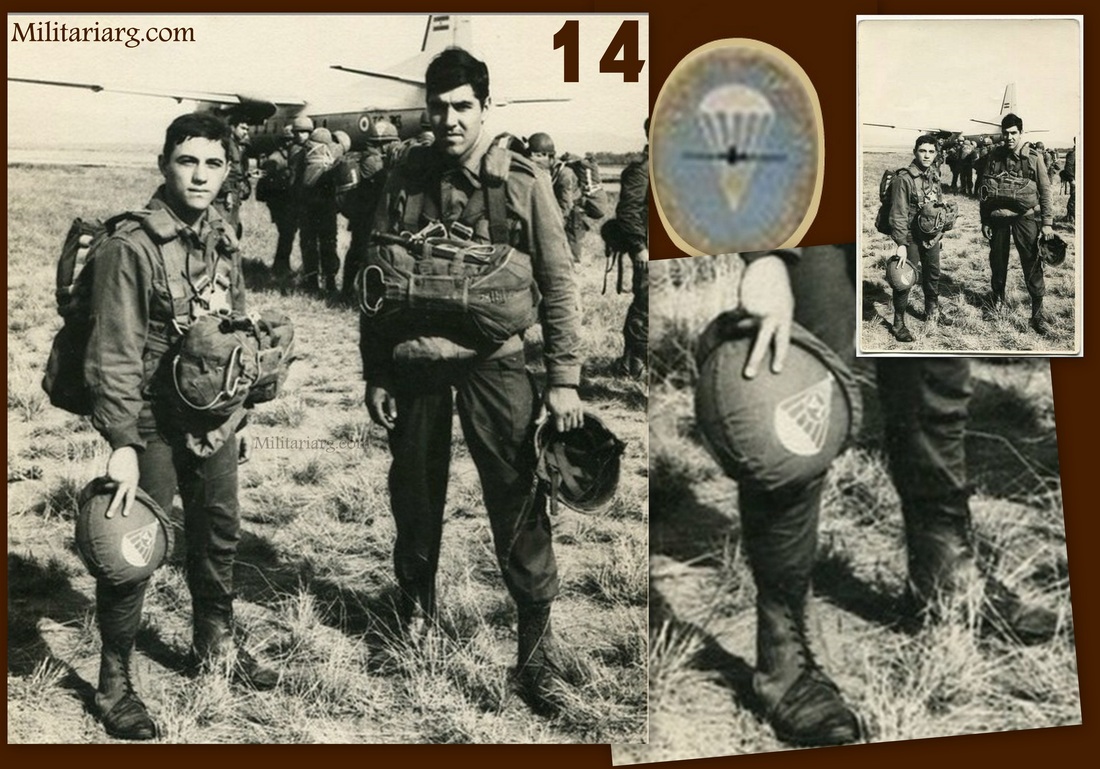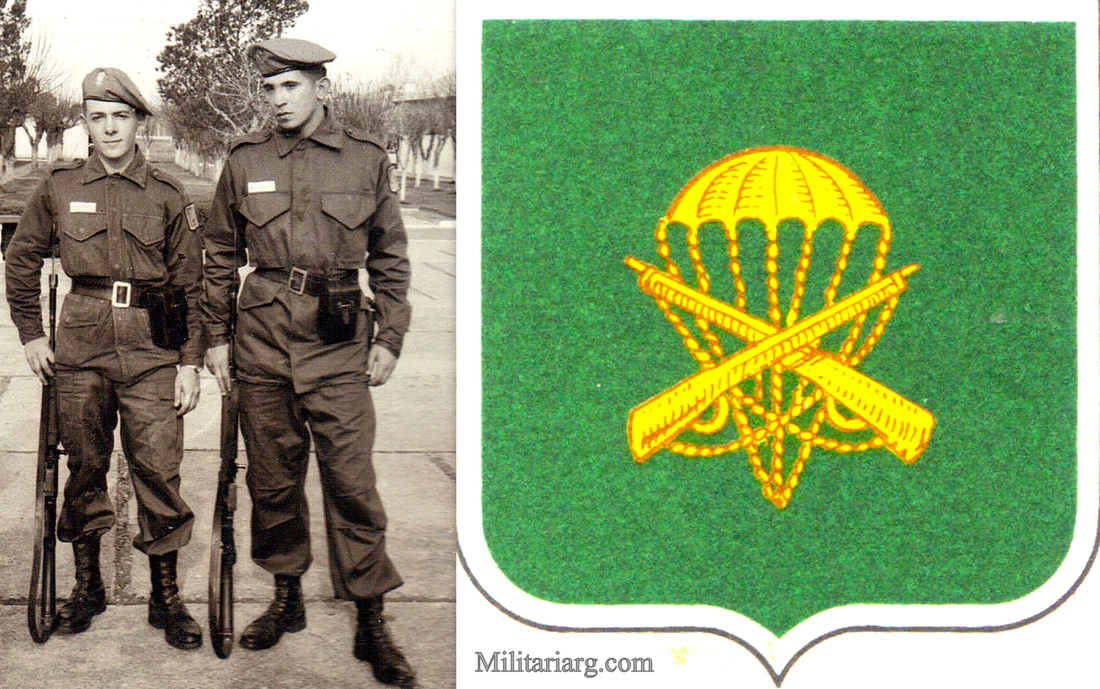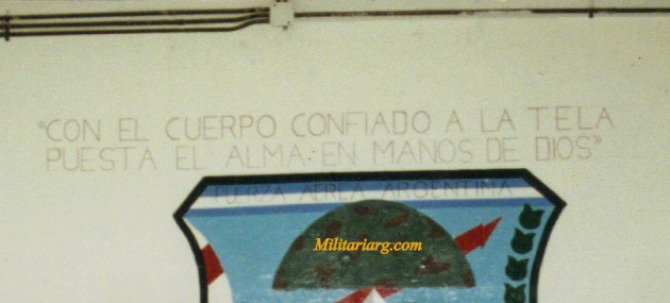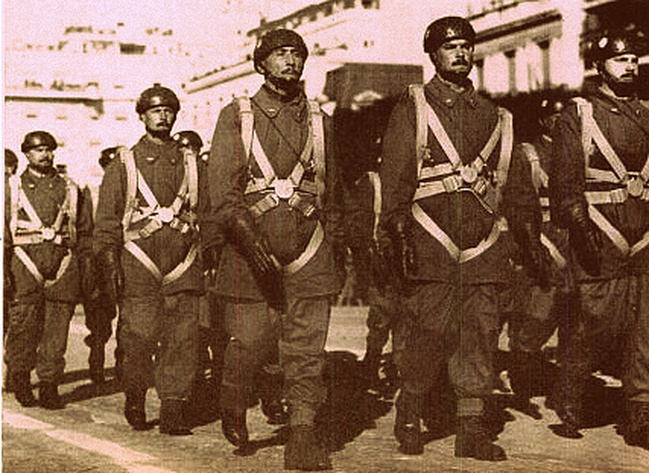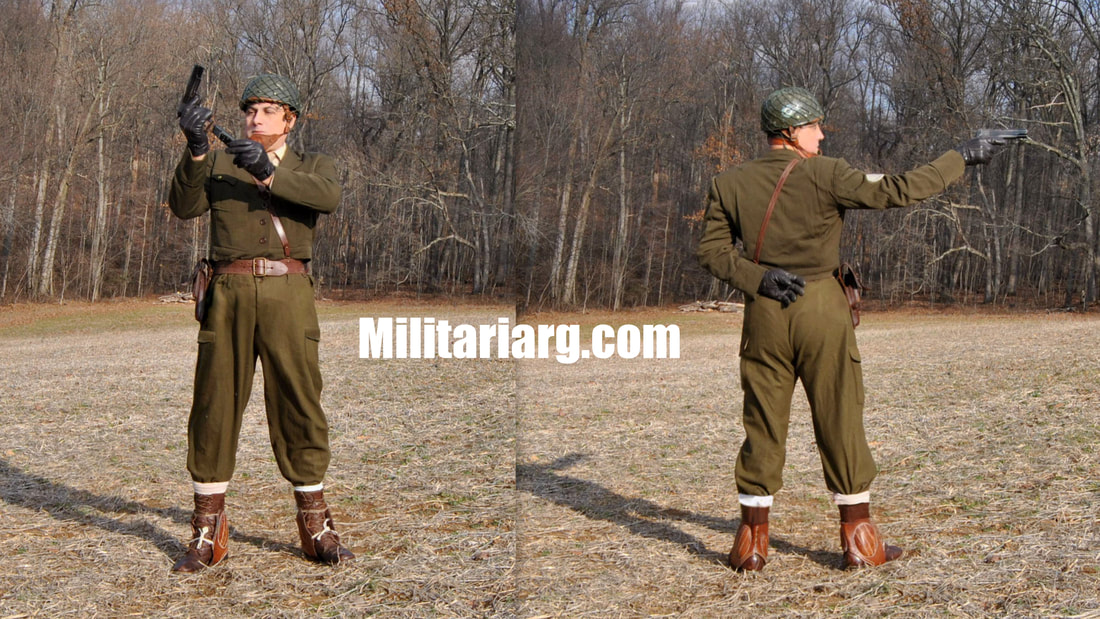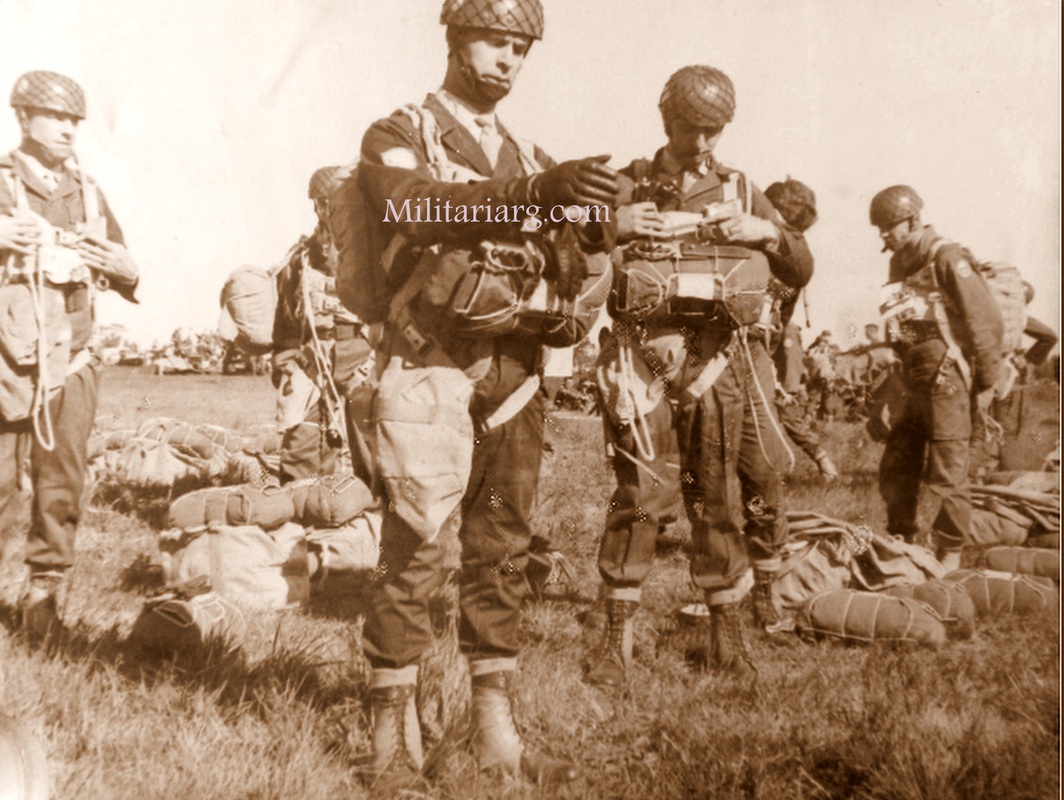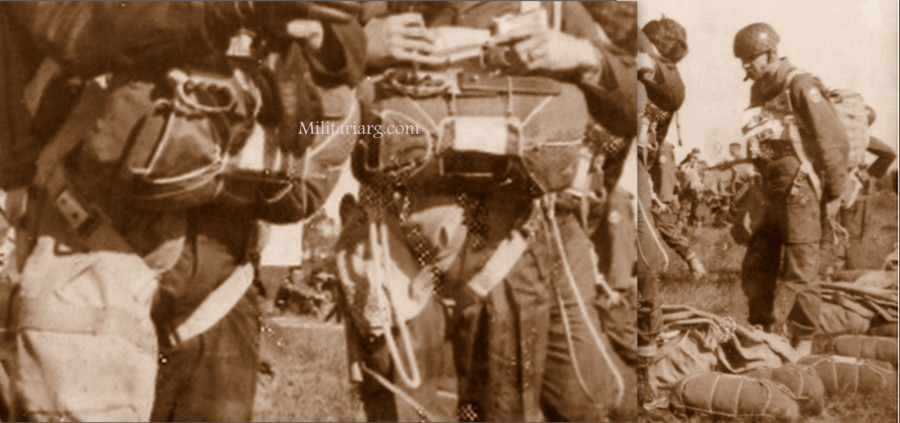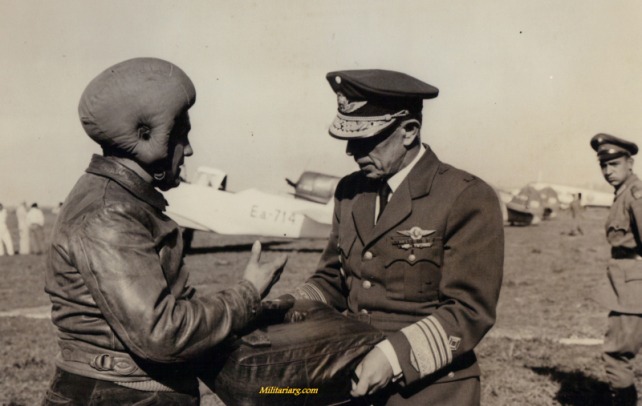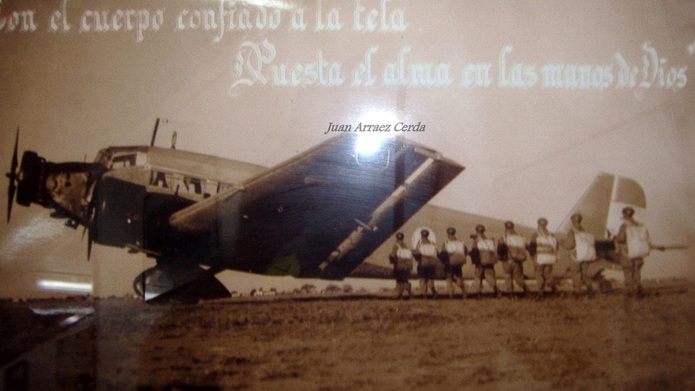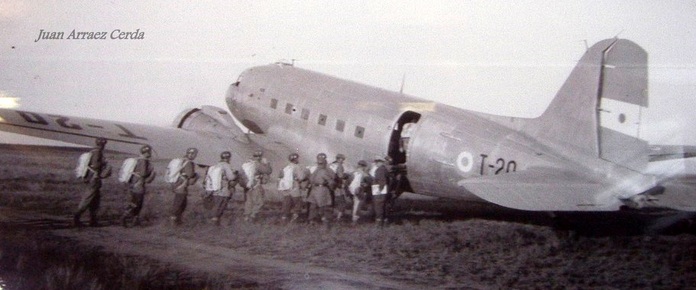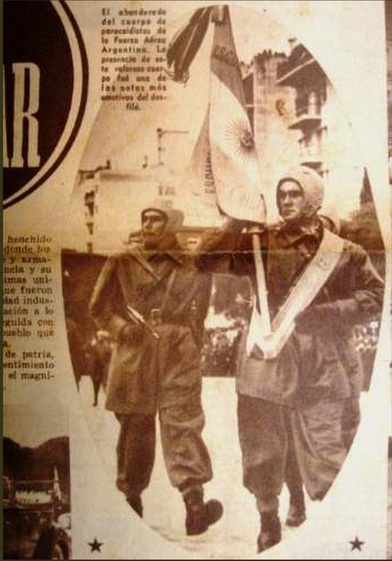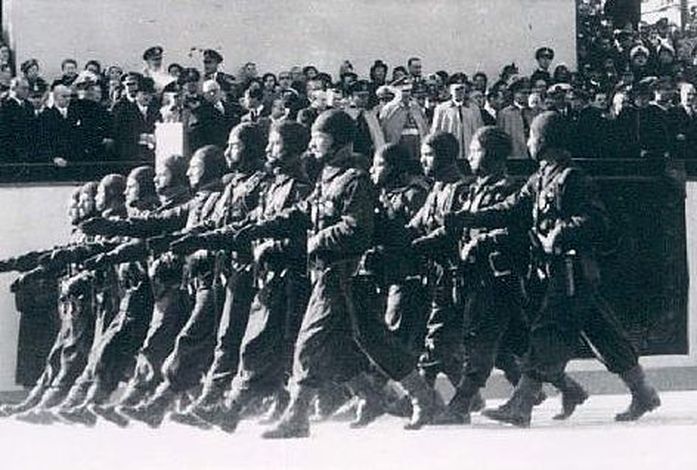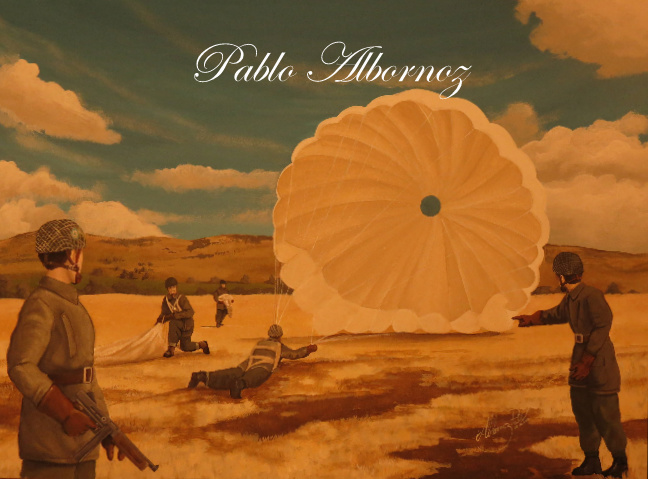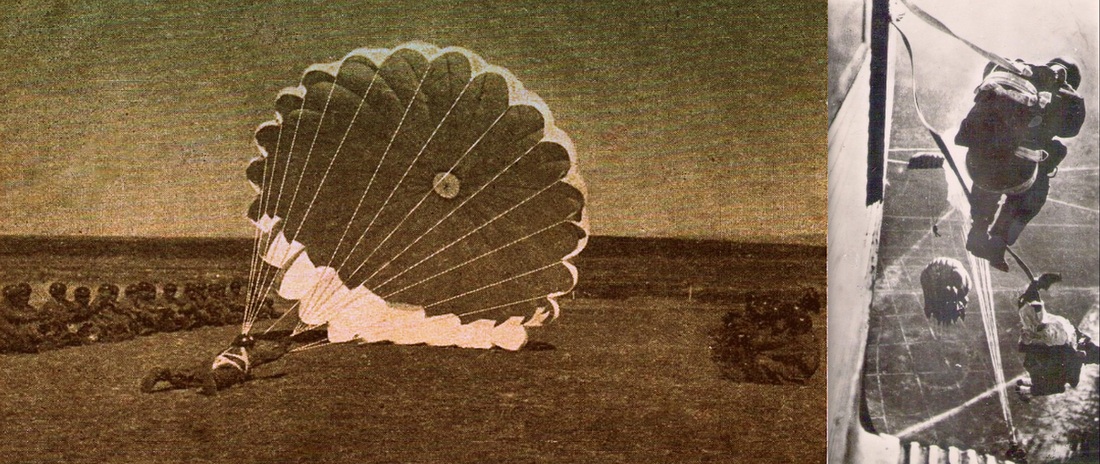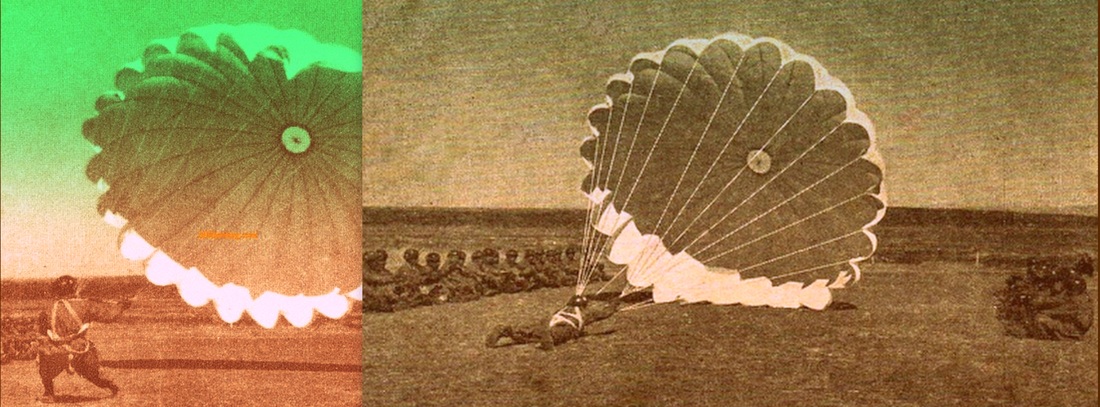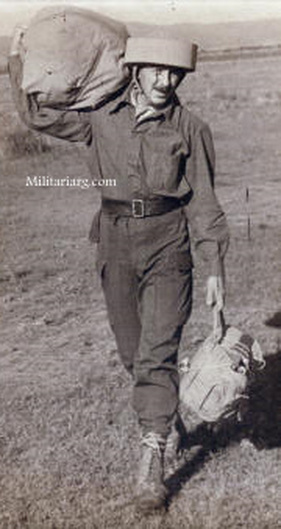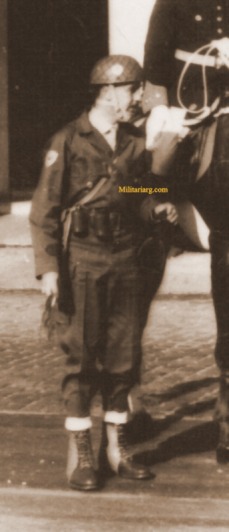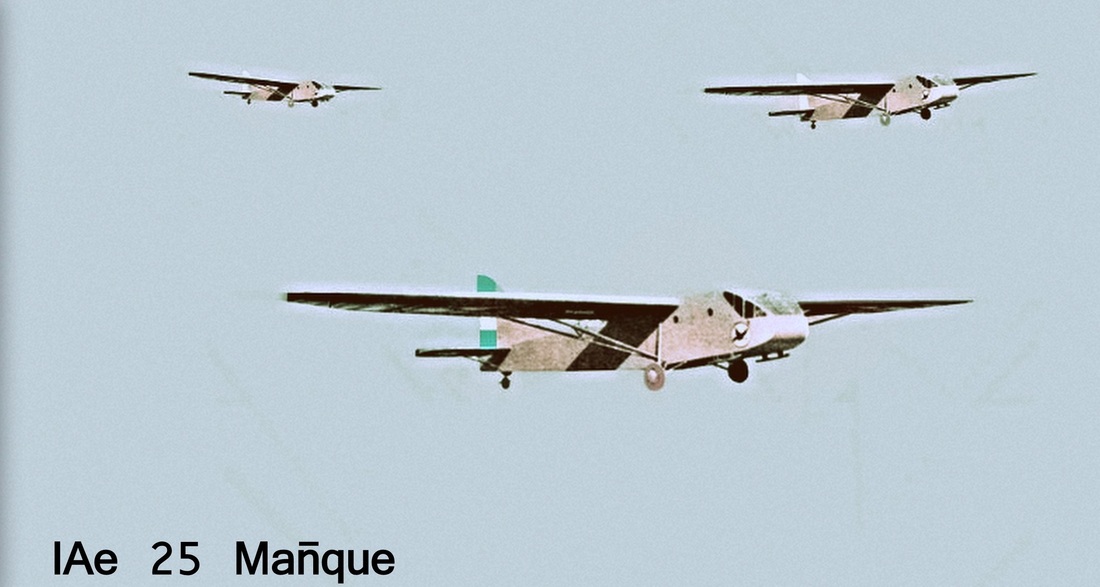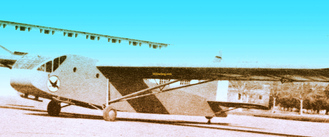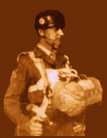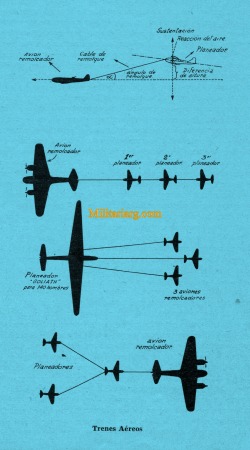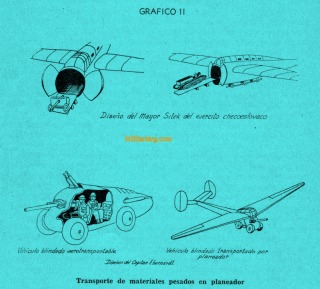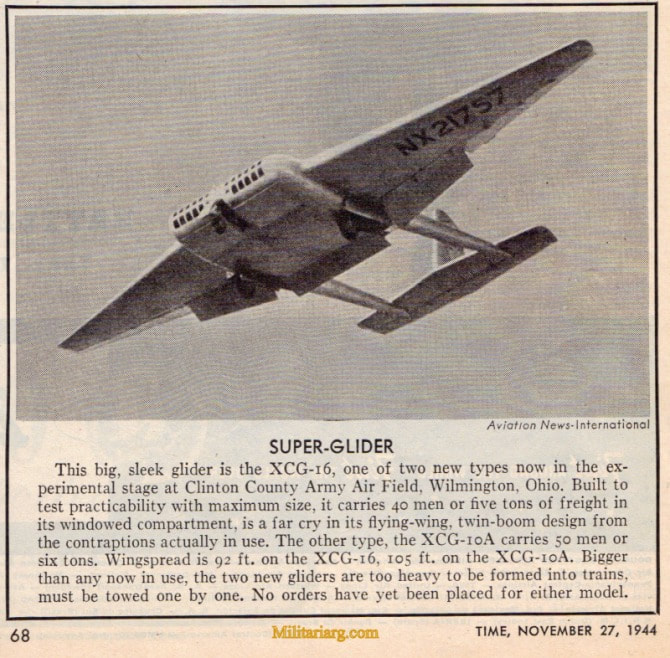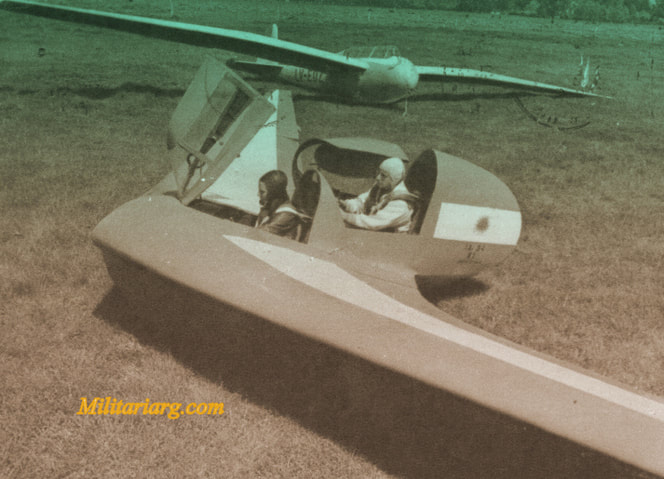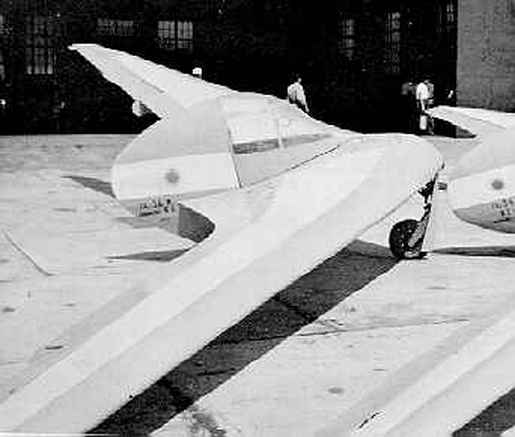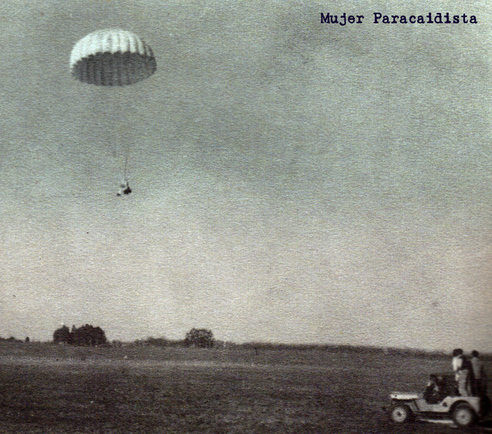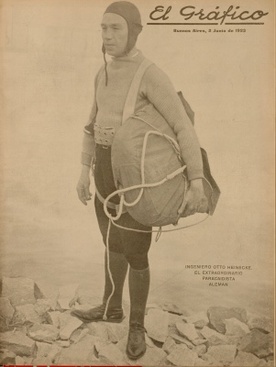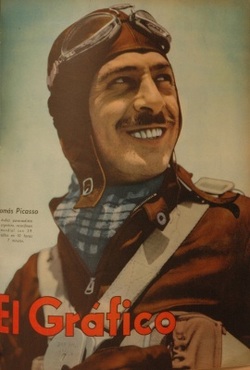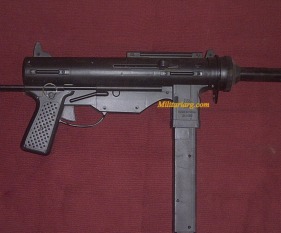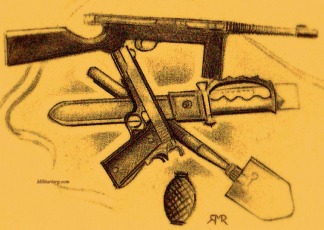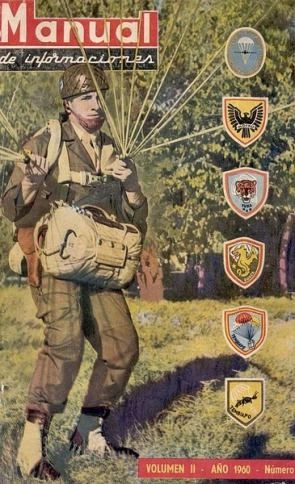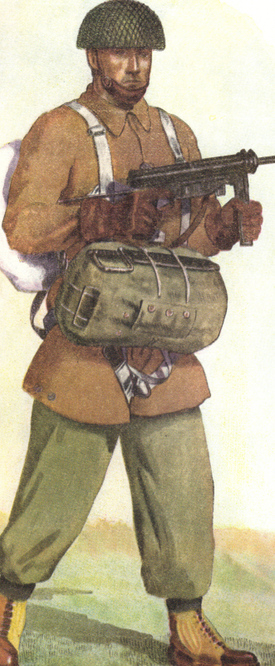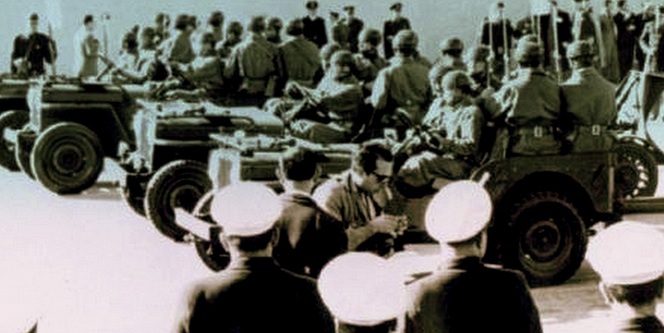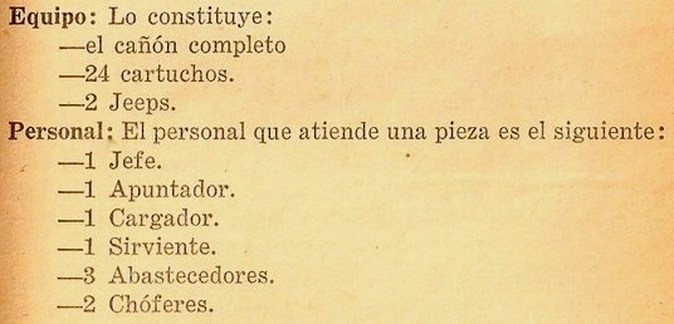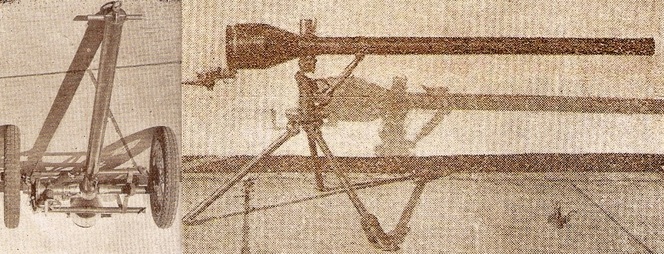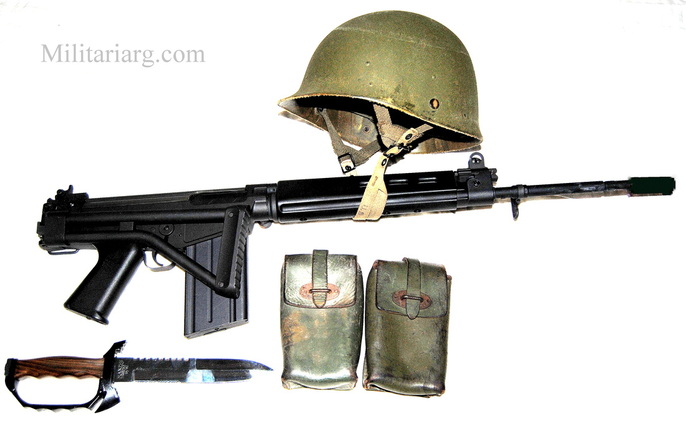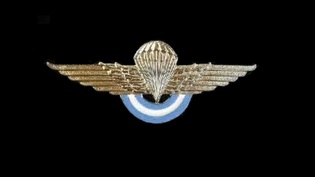Halcon Army Model M49 Sub-Machine Guns.
Argentine Paratrooper 1940s/50s. Photo Reenactment.
Halcon 9mm Mod 1949 double ammo pouch.
Ranz paratrooper knife 19/80.
Left: Original WW2 Argentine airborne helmet. Right: German PARA helmet ET71 with spanner bolt tool .
Paratrooper Scarf Camo, made out of original parachute fabric. Pablo Bustamante Loarder Collection.
MC1-1C Parachute harness for a rather T-10 or MC1-1 series static line backpack deployment bags parachute system. T-10R Chest Parachute Reserve SLCP/MIRPS modified and Parachute and harness for Extra-Cargo, equipments and weapons.
FMA Type T-5/10 Nylon Parachute
14th Airborne Regiment. 1969 (Uniform Pattern M67). Right: Aerot 2 - 2nd Airborne Infantry Regiment "General Balcarce", Badge.
This is the motto of the Argentine paratroopers, "With the body trusting in the cloth, the soul is placed in God's hands."
Jump Smock and Institec Irvin Type Parachute.
Argentine Paratrooper middle 1950s - 60s. Photo reenactment impression.
IAME Parachute, Model INSTITEC.
Brigadier Bartolome De La Colina.
Formation and parachute training for the Spanish in Cordoba, Argentina in 1947 under the command of Captain Ramon Salas Larrazabal.
These are phoyos of pictures taken at the Base Aerea de Alcantarilla, a branch of the Military School of Parachuting in Spain by Spanish aeronautical historian Juan Arraez Cerda.
Junkers JU-52
Douglas C-47.
Photo: UPI/AP
ARGENTINE PARATROOPERS
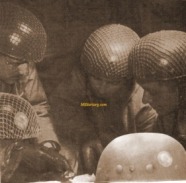
In the mid-20th century the emergence of the paratroopers was truly an event and a success at the military, tactical and strategic level because of its possibilities. They were first shown in exhibitions by the Russians and then operating on the ground by the Germans. These elite forces like the marines and mountain troops occupied the spot of innovators as the cuirassiers and hussars did in the 19th century (Napoloeonic Wars).
Our country was a pioneer in South America in the use of these airborne forces and the fifth in the world for its time. The success of their jobs depended on their own and other factors: mechanics, technicians, meteorological, human and sometimes providence, hence its motto: With the body trusting in the cloth, the soul is placed in God's hands.
Our country was a pioneer in South America in the use of these airborne forces and the fifth in the world for its time. The success of their jobs depended on their own and other factors: mechanics, technicians, meteorological, human and sometimes providence, hence its motto: With the body trusting in the cloth, the soul is placed in God's hands.
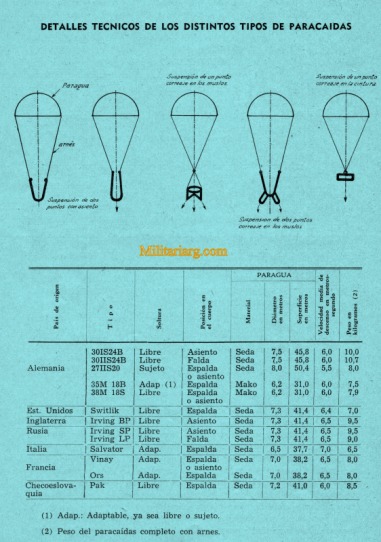
Experience is important to each parachutist through jumps, their individual level and teamwork. Some important factors are external: weather conditions, air currents, the type of parachute, its composition (silk or mako for that time), position (seat, flank or back, adaptable, free or subject, manual machine, etc.). In reference to the types of parachutes that were presented during WWII, the models were suspended from two points of the umbrella, where the parachustist was mounted on the seat and two-point belt on the thighs and the belt at the waist. Germany used parachute model types 35 and 38 (18B/S) (30IS24B and 30IIS24B) and 27IIS20. The United States used the type Switlik, England the Irving BP, Russia's SP and LP Irving, Czechoslovakia and Italy's Salvatore Pal. All with a wide variety of material and speed and weight capacity.
Simulated training is extremely important for practice in heights and rotation. It is where one learns to control the spins on axis, which happens to the body during the free fall to counter natural forces such as inertia, gravity versus opposition from the air, swings to open the fabric and hang in the air.
All of these movements are extended to the point where the sails drop and the harness is released to avoid being dragged. To achieve this, the force of arms and legs are essential since the effort to counter the speed of free falling body and adopt the position of the moment of opening of the fabric.
Jump positions are very important. The horizontal position called "Angel" is a classic jump. The jumper deploys horizontally across which provides greater control of the body and is less likely to become entangled with the cloth when opened. Another is the angle position (Tent Jump), which reacts to the parachute by extending the arms and legs to release the air resistance.
The worst position of all is undoubtedly the somersault (where the skydiver takes a kind of ball position) because it is so difficult to regain control of the body in the rotary movement that gives this position for the fall. Any extra movement during the free fall can disrupt and destabilize the jump event after which the parachutist will counter with their preparation, their nerves and physical strength to make the time to open the fabric, often opening force causing them minor injuries. In order to achieve success, the jumper must yield physical and mental control of their movements when making the jump, depending on the aircraft speed, type of jump position taken to avoid being hit by the fuselage and pushed into the queue, the type of parachute, manual or automatic ability to open between 120 and 150 meters or even less with the manual capacity of the lever, for greater precision rendezvous with the rest of his group.
Depending on the speed of the aircraft, the group's cadence of the leaps is often just seconds. The distance to reach the rendezvous point in a radius of no more than 400 meters and always with the goal of reuniting quickly. This would have brought together a greater number of men in approximate space and time. During WWII entire battalions were launched, numbering 40 men per aircraft. The airplanes took a wedge or delta formation at 300km/h, as high as possible to avoid being struck by other aircraft. In addition to using techniques during free fall and coordinating all these factors at the time of descent to the handling of the sails in order to avoid being dragged on the ground and then moving to combat positions, the paratrooper returns to being one more soldier on earth.
During military operations the parachutist is also overcome by a series of dangers ranging from the possibility of being hit with the group on the same plane by anti-aircraft artillery, the perils of the jump and being lucky not to be hit by anti-aircraft ammo and being easy targets due to the defenseless positions on the ground.
Even at landfall, the danger does not end for the skydiver. They must detach themselves from the parachute harness and seek cover in the shortest time possible and then meet with the group. He then becomes a soldier but with little equipment, basically the capacity of the parachute that can enable (100kg), handguns (seasonal) like 11.25 or systems Ballester Molina Colt and Halcon 45, flares, knife mount for the melee, blade Linemann, survival skills and associated items such as water purification, chlorine tablets, medical supplies, land navigation elements, practical clothing such as coveralls and rubber soled boots, paratrooper helmet-in our case the classic model of the 1940s, the non-ballistic spherical shape without wings.
The groups of paratroopers on special operations are small. They adopt land formations for patrol, fought even behind enemy lines with exploration targets, reconnaissance and observation, besides eventually acting as gunners and sappers. For large span operations in different climates and terrain, where they need a higher number of troops, every 3-5 paratroopers are thrown together with their equipment, supplies and weapons in special containers, painted in bright colors for quick reclamation on land. The equipment dropped ranges from light to heavy weaponry for th etime. The Madsen machine gun 7.63 for anti-aircraft or ground support, Puma type motorcycles (according to the German experience which our country adopted)20mm antitank tubes, detachable mountain artillery, all in separate containers with 2 or 3 each for the parachute drop. All were indispensable to the ground support of airborne forces, according to experience of the Second World War, especially by the German Fallschirmjager.
Reference: Boletin de Informaciones Aeronauticas 1945 and from the now extinct magazine "Alas Argentinas".
Simulated training is extremely important for practice in heights and rotation. It is where one learns to control the spins on axis, which happens to the body during the free fall to counter natural forces such as inertia, gravity versus opposition from the air, swings to open the fabric and hang in the air.
All of these movements are extended to the point where the sails drop and the harness is released to avoid being dragged. To achieve this, the force of arms and legs are essential since the effort to counter the speed of free falling body and adopt the position of the moment of opening of the fabric.
Jump positions are very important. The horizontal position called "Angel" is a classic jump. The jumper deploys horizontally across which provides greater control of the body and is less likely to become entangled with the cloth when opened. Another is the angle position (Tent Jump), which reacts to the parachute by extending the arms and legs to release the air resistance.
The worst position of all is undoubtedly the somersault (where the skydiver takes a kind of ball position) because it is so difficult to regain control of the body in the rotary movement that gives this position for the fall. Any extra movement during the free fall can disrupt and destabilize the jump event after which the parachutist will counter with their preparation, their nerves and physical strength to make the time to open the fabric, often opening force causing them minor injuries. In order to achieve success, the jumper must yield physical and mental control of their movements when making the jump, depending on the aircraft speed, type of jump position taken to avoid being hit by the fuselage and pushed into the queue, the type of parachute, manual or automatic ability to open between 120 and 150 meters or even less with the manual capacity of the lever, for greater precision rendezvous with the rest of his group.
Depending on the speed of the aircraft, the group's cadence of the leaps is often just seconds. The distance to reach the rendezvous point in a radius of no more than 400 meters and always with the goal of reuniting quickly. This would have brought together a greater number of men in approximate space and time. During WWII entire battalions were launched, numbering 40 men per aircraft. The airplanes took a wedge or delta formation at 300km/h, as high as possible to avoid being struck by other aircraft. In addition to using techniques during free fall and coordinating all these factors at the time of descent to the handling of the sails in order to avoid being dragged on the ground and then moving to combat positions, the paratrooper returns to being one more soldier on earth.
During military operations the parachutist is also overcome by a series of dangers ranging from the possibility of being hit with the group on the same plane by anti-aircraft artillery, the perils of the jump and being lucky not to be hit by anti-aircraft ammo and being easy targets due to the defenseless positions on the ground.
Even at landfall, the danger does not end for the skydiver. They must detach themselves from the parachute harness and seek cover in the shortest time possible and then meet with the group. He then becomes a soldier but with little equipment, basically the capacity of the parachute that can enable (100kg), handguns (seasonal) like 11.25 or systems Ballester Molina Colt and Halcon 45, flares, knife mount for the melee, blade Linemann, survival skills and associated items such as water purification, chlorine tablets, medical supplies, land navigation elements, practical clothing such as coveralls and rubber soled boots, paratrooper helmet-in our case the classic model of the 1940s, the non-ballistic spherical shape without wings.
The groups of paratroopers on special operations are small. They adopt land formations for patrol, fought even behind enemy lines with exploration targets, reconnaissance and observation, besides eventually acting as gunners and sappers. For large span operations in different climates and terrain, where they need a higher number of troops, every 3-5 paratroopers are thrown together with their equipment, supplies and weapons in special containers, painted in bright colors for quick reclamation on land. The equipment dropped ranges from light to heavy weaponry for th etime. The Madsen machine gun 7.63 for anti-aircraft or ground support, Puma type motorcycles (according to the German experience which our country adopted)20mm antitank tubes, detachable mountain artillery, all in separate containers with 2 or 3 each for the parachute drop. All were indispensable to the ground support of airborne forces, according to experience of the Second World War, especially by the German Fallschirmjager.
Reference: Boletin de Informaciones Aeronauticas 1945 and from the now extinct magazine "Alas Argentinas".
"Battle Passengers"
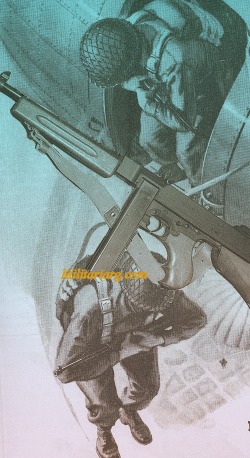
The image is a replica of the Thompson submachine gun .45 calibre ACP. The background is from an old advertisement for Douglas Aircraft during WWII with the title "Battle Passengers: They, Too, Depend on Douglas." According to a quote on Wikipedia, "The Argentine company Hafdasa and the Buenos Aires based firm Halcon manufactured the C-4 and M-1943 submachine guns which have a very similar layout and performance to the Thompson Gun, both weapons chambered in 9x19mm for the Argentine Army and .45 ACP for the Argentine Police forces. These weapons were a serious contender to the Thompson Gun but did not see much service outside Argentina."
Photos of practice jumps for Argentine paratroopers in the 1940s. Photos from "Alas Argentinas" magazine publsihed in the 1950s.
Iae 25 Manqué. Computarized Image.
The I.Ae. 25 Mañque was an Argentine airborn assault troop/cargo glider designed in 1945. It was later cancelled. Photo from the publication "La Aeronautica Nacional Al Servicio del Pais" by the Aeronautical Secretary of Argentina.
The I.Ae 25 Manque was an aircraft developed for glider operations for the transportation of 13-15 Airborne Troops heavily equipped, plus two pilots.
They were launched by aircraft powerful enough to tow them from the ground and drop to height in the air. When not motorizados, speed gains strength in the vertical plane.
It was composed entirely of native wood from the country and, possibily, in cloth as the rest of the contemporary gliders.
Its fuselage was rectangular, with a tricycle landing gear. The pilots' windows were direct vision panels, which show that the aerodynamic design was sacrificed for better visibility for pilots. This is not accidental, but rather because the aerodynamic design of the cargo aircraft is not of vital importance.
This type of non-motorized aircraft (Glider) trailer depended on a military transport plane according to the characteristics of the glider to be towed. Depending on the tug power, a plane could carry several gliders from a single tow in the form of hang gliding that were linked together.
When the transport plane neared the landing zone, it released the hooks and bungee cords of the glider and they began to have autonomy in flight.
The troop transport planes began to launch troops and they where the first to arrive in the landing area. It is in the landing area or meeting point where the glider pilots must land the load. They had to pay close attention to the exact place of landing in order to be helped from the ground by airborne troops to guide them with signs like flares.
The structure of these ships was generally light wood and fabric, however they could carry heavy loads due to aerodynamic lift over the opposition air.
Aircraft with a greater wingspan, like the Airspeed Horsa (constructed in cylindrical sections), could even carry a load slightly less than its own weight of 3 tons.
The largest glider for troops was the German Goliath, which could transport up to 140 heavily equipped men, although this number was not really tested during the war due to Germany's lost air power.
Beyond the practicality in terms of load and weight on the same flight, it was also a great vulnerability to ground fire.
The most used glider was undoubtedly the Waco CG-4, built by the US, in quantities of more than 13,000 from 1942 when the Allies had secured control of air and the possibility of large airborne operations. The British were not far behind and built a number of Airspeed Horsa to transport heavy equipment, artillery and support vehicles, including bombs.
Graphics are from the "Boletin de Informaciones Aeronauticas" January 1945, a publication from the Argentine Aeronautic chief.
Super Gliders
Above is a clip from Time Magazine on the Super Glider XCG-16 from 1944.
Horten XV I.AE 34 "Clen Antu" which means "Sun Ray" in the local indigenous language. It was a tailless glider sailplane for advanced training manufactured between 1946 and 1950.
Horten XV I.AE 34 "Clen Antu" which means "Sun Ray" in the local indigenous language. It was a tailless glider sailplane for advanced training manufactured between 1946 and 1950.
I.Ae. 41 Urubú
First argentine woman to make a parachute jump.
On the left is a great replica of the M3 or "grease gun" made by GLD (Guide Lamp Division) GMC (General Motors Corp). The Argentina-based company Halcon (Fabrica de Armas Halcon) made two versions of this arm called the PAM 1 and 2. The drawing on the right is from the publication "La Aeronautica Nacional Al Servicio del Pais" from 1948. Pictured is the submachine gun Halcon ML-43 in 9mm parabellum and a version of the Colt (Ballester Molina) aka Hafdasa for the initials Hispano Argentino Fabrica de Automoviles S.A. The knife is Ranz made in Cordoba for the paratroopers. The shovel is a portable Lineman. Also shown is a grenade.
Airborne Troops w/ vehicles Willys CJ-2A pushing 75mm M20 Recoilless gun or recoilless rifle (DGFM) . Photo: Archivo Gral de la Nacion.
DGFM.75mm M20 Recoilless gun or recoilless rifle, Modelo Argentino.
DGFM 75mm ammunition and spotting scope, Carl Zeiss Optical (type). Photo: "Las armas modernas de la infanteria" by Julio Guzman. 1953.
